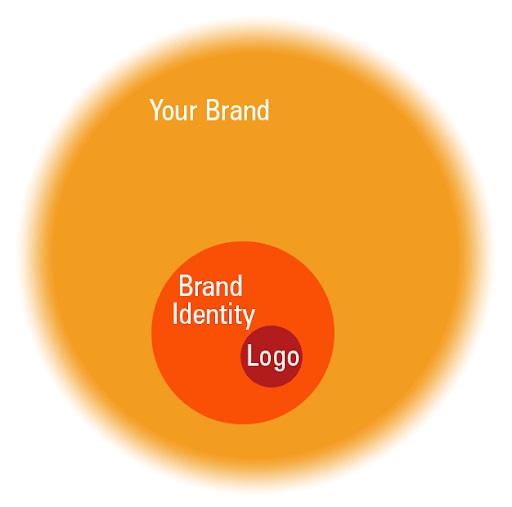
Branding vs Design: 5 key Differences Which Matters

The often ambiguous term “Branding” is very well known to all of us. Yet unknown. Most people use Branding synonymous with Design. However, both the terms have significantly different meanings and roles.
First of all, let us understand what is Branding. Most companies understand the importance of Branding and put in a lot of effort to build a strong brand for their business. All the strategies and exercises involved in creating the brand result in a collective impression on the people’s minds. Hence, Branding is a result. It is the customers’ gut feeling about a product/service/company. It’s your reputation. Your brand should have a voice that talks to people, a personality that makes you unique from your competitors, and a look that lasts in their minds. About 70% of marketers believe branding is critical for growth.
Now the symbolic visual elements that make up your brand are called Design. The branding design ideas encompass all the key branding elements such as Logo, Color scheme, Typography, etc. A branding design makes the Brand name recognizable to the customers. It helps in building trust and credibility. Also, 45% of the customers want companies to make great designs across marketing and sales collateral.
Therefore, a brand is not just what you see. It is also a feeling. For instance, the Lemon tree chain of Hotels based in India, greets its customers with a fresh and fun-spirited Lemon fragrance. Such attributes stir up the thoughts of association with the brand.
1. Foundation and Ridge
Branding is the foundation while design is the ridge. Whenever you start a business, setting the foundation is the key to build a brand. Your branding strategies act as a foundation for all marketing activities on which everything else is based upon. Building a strong base is paramount for any business as it carries the weight of other brand-building components including graphic design.
The design elements such as logos and fonts are the building blocks of the Brand. They give your brand identity. In a layman’s language, it is the look of a brand. People see and remember it.
2. Subset
Design is a subset of branding. While branding is a broader concept, design is one of the elements that build a brand. A graphic design should be backed by a branding strategy. Otherwise, it will never withstand the market. The term branding comprises 2 broad elements-
- Brand Strategy
- Brand identity design

Image Source – Visiblelogic
The term Brand identity design deals with visual aspects that define a brand. The logos, colors, and fonts give a recognizable identity to your brand. In fact, about 61% of marketers feel visual content is absolutely necessary to their marketing strategies.
3. Recognition
Design makes the brand recognizable. Do you remember the golden arched M on a red background? Yes, it’s McDonald’s. That is how design makes your brand recognizable. A strong visual identity can be persuasive. It should be unique and be able to mark a lasting impression on the customers.
The importance of design cannot be understated as it represents the face of your brand. The target audience recognizes your brand the moment they see your logo, packaging, website, signage, etc. Additionally, factors like color have a huge impact on your brand recognition. In fact, you can increase your brand recognition by 80% using a signature color.

Image Source – Justcreative
4. Brand Strategist and Designer
Building a brand requires both a brand strategist and a designer. Branding is a comprehensive process involving forming a brand strategy and designing a brand identity. You need both these aspects to work in harmony to build your brand. Therefore, building your brand requires a Brand strategist and a Designer to work in close coordination to make your branding exercise a success.
The Brand strategist is responsible for creating your brand architecture which forms the foundation of your branding process. However, the designer resonates with the vision of a Brand strategist and uses various tools to build the brand.
5. Brand Building
Design is a tool to build a Brand. A lot of tools and strategies come in handy while you are building your brand. Amongst other tools, Graphic Design is an important one to ensure your brand identity is strong and vibrant. Without a good design, branding strategy is rendered useless. As depicted in the image below, good design is crucial for branding for a small business.
Designers adopt a lot of tools and techniques to devise the perfect designing plan. One such technique being, the gestalt principles of design, commonly used by Logo designers. The theory states that a human mind is subconsciously guided by some principles. Such principles being Proximity, Closure, Continuity, Similarity, and Multi-stability can be used by businesses to make their logo memorable.

Image Source – Canva
Branding is a comprehensive process, and unlike a logo, its scope is not limited. Instead, it is the end result of visual identity, products, brand name, advertising, and of course, logo design as well. In a nutshell, Branding is constructing the whole process, while Design is a part of that process.
Conclusion
In this highly competitive world, it is your brand that connects you with your audience. If you are still wondering why branding is important, know that 89% of consumers relate to brands that share the same values as them. Hence, devising a robust branding strategy with great designs not only promotes customer recognition but also boosts your sales. If you’re ready to reinvigorate your branding, make sure to check out the latest branding trends for 2022.
We’d love help you with complete brand identity for your business, reach us here